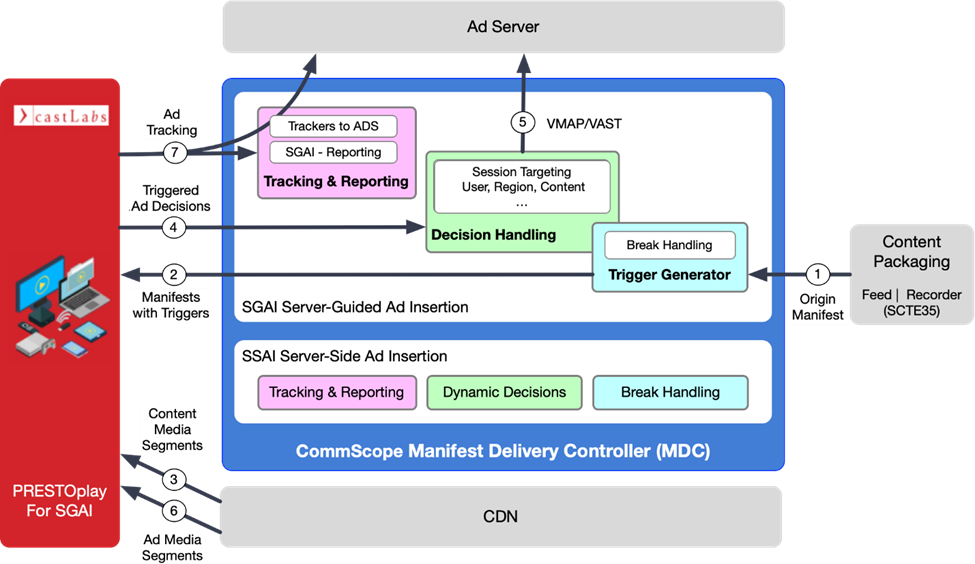Amid the shift to streaming technology, live TV remains a big part of many people’s entertainment experiences and a major contributor to ad revenue. Modern services provide easier access to content and greater control, like the ability to pause a live stream or start at the beginning of a favorite program. This creates challenges for delivering ads across the full user journey.
The Manifest Delivery Controller (MDC) from CommScope, combined with castLabs’ PRESTOplay for Addressable TV ads, demonstrate how server-guided ad insertion can help achieve greater ad delivery efficiency and increase ad revenue on compute-intensive time-shifted playback experiences.
Why it matters
Traditional methods of ad insertion on IP video include server-side ad insertion (SSAI) and client-side ad insertion (CSAI).
As the name implies, CSAI uses the client to fetch the ads and splice them into the primary content. However, because it typically requires the use of separate players, CSAI can cause interruptions and buffering, especially when ads are not properly conditioned to match the primary content codec and resolution profiles.
SSAI stitches the ads in the primary content in the network using technology called manifest manipulation. This ensures a seamless, high-quality streaming experience without any buffering. The other advantages provided by SSAI include the ability to prevent ad blocking and to better control ad conditioning. This is why SSAI is traditionally used for live streaming applications.
But as sports broadcasts drive an increasing share of streaming audiences, the lines are blurred between live, time-shifted and on-demand content. Users now have the ability to pause a live stream or play a channel from the beginning of a program to avoid missing any part of it; they can also simply record a program to watch it later. This means manifests get longer, involving more processing and bigger payloads to transport, driving infrastructure costs higher. Longer DVR windows also mean that some ads may get spliced into the manifest and never be viewed if users are playing behind the live event and stop the stream early. The result is unused ad decisions and less control of the ad experience.
Server-guided ad insertion
Server-guided ad insertion (SGAI) falls somewhere between CSAI and SSAI. It involves methods to schedule ad events in the manifest, with a pointer that allows the client to separately fetch ad pods from a manifest manipulator and splice them into the content.
This separation means the primary content manifest is cacheable while it is still possible to separately deliver and track ads for each client, resulting in both greater delivery efficiency and full addressability.
SGAI supports use cases such as pre-roll, mid-roll and post-roll ad insertion in video on demand (VOD) as well as ad replacement in live and time-shifted content. In addition, by separating ad decision fetching, SGAI enables the concept of late binding, where separate ad decisions are requested for each break only when the player is close to playing the ads. This means optimal ad decisions, reduced waste and lower start times, especially with manifests involving longer DVR windows such as time-shifted TV experiences.
The CommScope-castLabs solution
CommScope provides the MDC solution, a highly scalable, flexible and resilient manifest manipulation product for the personalization and monetization of IP video. castLabs provides PRESTOplay for Addressable TV ads, an extension of the PRESTOplay suite of clients available across web, Apple and Android devices.

Collectively, MDC and PRESTOplay leverage standards such as HLS Interstitials (today) and DASH MPD Insertion Events (soon) for ad avail detection and ad pod delivery. They also support advanced ad tracking and measurement capabilities, including the IAB Open Measurement, to increase transparency and trust for ad budgets.
MDC can adapt the primary content manifest to facilitate SGAI implementation in any packager environment.
Together, CommScope’s MDC and castLabs’ PRESTOplay benefit service providers by improving manifest delivery efficiency, reducing video start times and optimizing ad inventory and decisions.
Delivering consistent quality across SSAI and SGAI
SGAI finds its sweet spot in streaming experiences involving manifests with longer DVR windows. SSAI’s biggest advantage is that it is client-agnostic because there is no ad logic in the device other than tracking and measurement capabilities (for which castLabs provides PRESTOads, a player-agnostic ad SDK). As a result, it scales particularly well in environments involving many devices with multiple stacks to maintain, which can be generically extended with PRESTOads.
This is why MDC is designed to support SGAI alongside SSAI, with the ability to enable either mode by device or service. As such, the combination of MDC, PRESTOplay and PRESTOads, provides more versatility to adapt to any environment in order to increase ad revenue while reducing costs and improving the user experience.
A more profitable model from castLabs and CommScope
The “Real TV” experience emphasized by modern day video services rests on profitably growing revenue, reducing costs and improving the user experience. Ad insertion technology must adapt to maintain high ad value, delivery efficiency and a pristine user experience across devices and streaming use cases. CommScope’s MDC extends SSAI support with SGAI in conjunction with castLabs’ PRESTOplay for Addressable TV Ads to support monetization across the entire user journey.
You can learn more about the CommScope MDC solution, including features, benefits and specifications at the MDC product page.